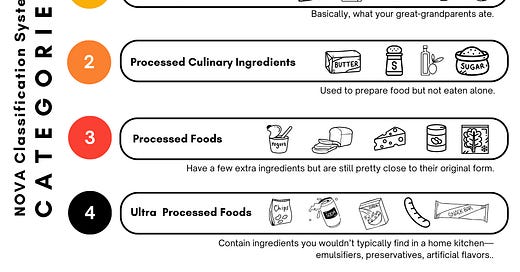Welcome to Fed—I’m thrilled you’re here! This is your go-to resource for nutrition questions and controversies. Think of me as your tutor—here to break down the noise, offer context, and help make sense of it all.
5 Questions Answered in Post:
I love reading labels and tracking macros. If I keep my calories in check, I won’t gain weight, right?
Apart from weight gain, is there anything inherently unhealthy about ultra-processed foods?
If I focus on sugar-free and fat-free options, will ultra-processed foods still increase my risk for cardiovascular disease?
Do I have to avoid all ultra-processed foods? Because honestly, I feel doomed—most of what I buy falls into that category.
I’m overwhelmed. How do I navigate all of this without losing my mind?
If you’ve scrolled through the news lately, you’ve probably seen a lot of scary-sounding headlines about food dyes, additives, and mysterious ingredients lurking in your meals and snacks. Should you be worried, or is this just another round of confused fear-mongering?
Ultra-Processed Foods: What’s the Big Deal?
Those alarming headlines are really talking about ultra-processed foods (UPFs)—a term that sounds scientific but is pretty straightforward. Researchers in Brazil coined it as part of the NOVA classification system, which sorts foods into four categories based on how much industrial processing they’ve been through.
Here’s where things get tricky: that fourth category is a catch-all for everything from KIND Bars to Kool-Aid. It’s hard to imagine a modern kitchen without some ultra-processed foods—they’re just part of life in 2025. We’ve come to expect (and, let’s be honest, depend on) a certain level of convenience when it comes to our meals and snacks. But alongside that convenience, we should also expect something even more fundamental: safety and nutritional integrity. Sure, we choose what we eat, but those foods—processed or not—should be inherently wholesome, regardless of their fat content or calorie count.
Reading Nutrition Labels is Great… Until You Realize What’s Missing
For years, nutrition advice has focused on nutrient density—foods packed with vitamins, minerals, protein, and fiber. And that’s solid advice, but it doesn’t tell the whole story.
While it measures the “good stuff” in food, it completely ignores the extras—things like emulsifiers, additives, and colorants. These sneaky ingredients don’t add calories or nutrients, so they fly under the radar. But some studies suggest they may impact metabolism, gut bacteria, or appetite regulation—factors that don’t show up on a nutrition label.
And here’s something even more surprising: how a food is processed can be just as important as what’s in it. Take a whole potato and compare it to potato chips—frying doesn’t just add fat, it completely changes the texture. Suddenly, you can eat an entire bag before your stomach even realizes food has arrived.
Wait… Texture? Now I Have to Worry if Food is Soft or Hard?!
I know—it sounds ridiculous. But consider this: When you eat a whole apple, you have to chew it—a lot. That slow process sends signals to your brain that you’re eating. But when you drink apple juice? Those calories go down in seconds, and your body doesn’t get the same fullness cue.
Ultra-processed foods are often designed to be soft, crispy, or melt-in-your-mouth delicious, requiring minimal chewing and making it easier to consume way more than you need before your brain catches up. This might help explain why people eat significantly more calories when their diet is high in UPFs—even when the food’s nutrition label looks fine.
The Big Question: Are UPFs to Blame for Obesity & Disease?
Now for the million-dollar question: Are ultra-processed foods the villains behind rising obesity rates, diabetes, and metabolic disorders, or are they just innocent bystanders in a world where people are eating more and moving less?
A Brief History of How We Live and What We Eat
To put things in context, let’s take a little time-travel tour of U.S. nutrition trends:
📌 1950s: The average American diet was rich in whole foods, and ultra-processed foods weren’t even a thing. People cooked at home, and portion sizes were smaller. No one “worked out,” but everyone moved—cars were a luxury, TV was a novelty, and mobile devices weren’t even a dream.
📌 1980s: The low-fat craze took over. Fat was demonized, leading food manufacturers to swap it out for sugar and refined carbs. Supermarkets stocked 30% of their food supply as UPFs, accounting for 35% of daily calorie intake. Meanwhile, gyms became mainstream, and jogging took off, but daily movement declined as more people sat at desks. Home computers arrived, and TV screen time doubled.
📌 Today: Ultra-processed foods dominate the food supply, making up over 60% of daily calorie intake—some estimates say 70% of grocery store items fall into this category. We now have more gyms, more screens, and less movement. Technology killed incidental movement, and sedentary behavior is at an all-time high.
5 Questions
To make sense of it all, I’ll tackle the top five questions I get about ultra-processed foods, using the latest research to back up the answers.
I love reading labels and tracking macros. If I keep my calories in check, I won’t gain weight, right?
You’d think tracking macros and calories would be the ultimate defense against weight gain, but ultra-processed foods (UPFs) make it way too easy to overeat—without even realizing it. In a randomized controlled trial, participants on a UPF-heavy diet ate 500 extra calories per day and gained weight, even though their meals were matched for macros and nutrients. Another study found people eating UPFs chewed less, ate faster, and consumed 813 more calories daily—a perfect storm for overeating
The issue? UPFs override natural satiety signals. Think about a big bowl of arugula—there’s only so much you can eat before you’re just… over it. But with ultra-processed foods, that natural “I’ve had enough” response doesn’t kick in as quickly. UPFs are designed to be hyper-palatable, soft, and easy to chew, meaning you can eat more, faster, before your body even realizes it’s full. Plus, certain additives and emulsifiers may disrupt gut hormones and metabolism, making it even harder to regulate appetite
So yes, calories still count—but UPFs make them harder to control. If you want to stay on top of your intake, focus on whole, minimally processed foods that require more chewing and digestion. They naturally slow you down, keep you fuller longer, and help regulate appetite, so you don’t have to rely on willpower alone. It’s not just about what you eat but how your body responds to it.
Apart from weight gain, is there anything inherently unhealthy about ultra-processed foods?
Yes, but before you panic, let’s talk about balance. Ultra-processed foods aren’t inherently toxic, but research suggests that eating too many of them may impact your health in ways that go beyond just weight gain. One of the biggest concerns? Chronic, low-grade inflammation—which has been linked to conditions like heart disease, diabetes, and metabolic disorders.
Some UPFs contain additives like emulsifiers, preservatives, and artificial sweeteners, which studies suggest may alter gut bacteria and increase intestinal permeability (a.k.a. "leaky gut")—potentially leading to low-grade inflammation over time. Additionally, certain food packaging materials (think BPA and phthalates) have been shown to interact with our endocrine system, which could play a role in metabolism and insulin regulation. While occasional UPFs aren’t a deal-breaker, relying on them as dietary staples might tip the scales in the wrong direction when it comes to long-term health.
If I focus on sugar-free and fat-free options, will ultra-processed foods still increase my risk for cardiovascular disease?
Let’s talk about all those "healthier" ultra-processed foods—the sugar-free yogurts, fat-free salad dressings, high-protein snack bars, and diet sodas that seem like the perfect fix. They sound great in theory, but at the end of the day, they’re still ultra-processed, and they’re not doing your heart any favors. While they might cut back on sugar or fat, they often compensate with artificial sweeteners, emulsifiers, thickeners, and preservatives—all of which can still have negative effects on your cardiovascular health
Large-scale studies have shown that higher UPF consumption is linked to a 17% increased risk of cardiovascular disease, a 23% increased risk of coronary heart disease, and a 9% higher risk of stroke. One of the culprits? Chronic inflammation, which can be triggered by some of the additives in these foods, disrupting gut health and impacting blood vessel function. And let’s not forget about sodium, which is often sky-high in fat-free and sugar-free processed foods, driving up blood pressure and increasing heart disease risk.
So while reaching for sugar-free, fat-free, or high-protein ultra-processed foods might seem like the smarter choice, they don’t erase the risks associated with UPFs. A better approach? Prioritize whole, minimally processed foods whenever possible. A handful of nuts, full-fat plain yogurt, or even a little drizzle of olive oil on your salad will do a lot more for your heart than a fat-free dressing loaded with stabilizers. It's not just about what’s missing (sugar, fat), but about what’s been added in their place.
Do I have to avoid all ultra-processed foods? Because honestly, I feel doomed—most of what I buy falls into that category.
No need to panic—you don’t have to cut out all ultra-processed foods to be healthy, but how much and what kind you eat does matter. Research consistently shows that diets high in UPFs are linked to a greater risk of obesity, cardiovascular disease, and metabolic disorders. However, not all UPFs are created equal. Some—like fortified whole-grain bread, plain yogurt, and plant-based milk alternatives—can actually provide important nutrients. The real issue is that many UPFs are low in fiber, packed with additives, and designed to be eaten quickly and in large amounts—which makes it easy to overconsume.
At the end of the day, you don’t have to live off kale and quinoa to be healthy, but being mindful of the quality and quantity of UPFs in your diet can go a long way. Try to prioritize whole foods when possible, make smarter UPF choices, and aim for balance rather than perfection. A little bit of ultra-processing isn’t the problem—it’s when it becomes the bulk of your diet that things can go south.
I’m overwhelmed. How do I navigate all of this without losing my mind?
First, take a deep breath—you don’t have to banish ultra-processed foods (UPFs) entirely to improve your health. The goal isn’t perfection but balance. Making simple swaps—like choosing whole foods when possible, opting for fewer highly processed snacks, and prioritizing fiber-rich meals—can help support better digestion, metabolism, and overall well-being. Think of UPFs as a spectrum rather than an all-or-nothing choice. Some, like sugary cereals, packaged pastries, and soda, offer little nutritional value, while others, like certain fortified breads and plain yogurts, can still have a place in a healthy diet. If UPFs make up most of your meals, try shifting gradually toward more whole, fiber-rich foods—it’s a marathon, not a sprint.
One way to start? Do a quick inventory of your fridge, pantry, or snack drawer. Pick two UPFs and see if you can swap them for a less processed alternative. Once that feels normal, move on to the next two. I did this with crackers—I used to plow through a box of Wheat Thins without blinking. Then, I found Firehook crackers with a simpler ingredient list and a more satisfying texture. I can still enjoy crackers, but I eat fewer of them because they actually feel like food, not something designed for mindless munching.
And let’s be real—there are some UPFs you love or that just make life easier, and that’s totally fine. For me, that’s Trader Joe’s Soyaki marinade (great for a quick weeknight dinner of broiled chicken thighs) and dark chocolate KIND bars for when I’m on the golf course. The key is to keep UPFs to no more than about a third of your overall diet. That way, you can still enjoy the convenience without letting processed foods take over. Small, sustainable swaps add up, and before you know it, you’ll feel more in control—without feeling deprived.












